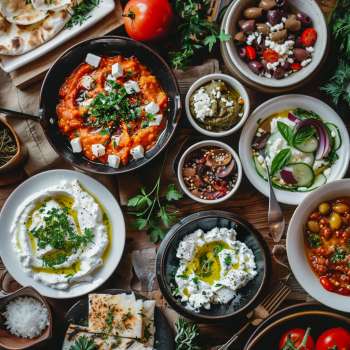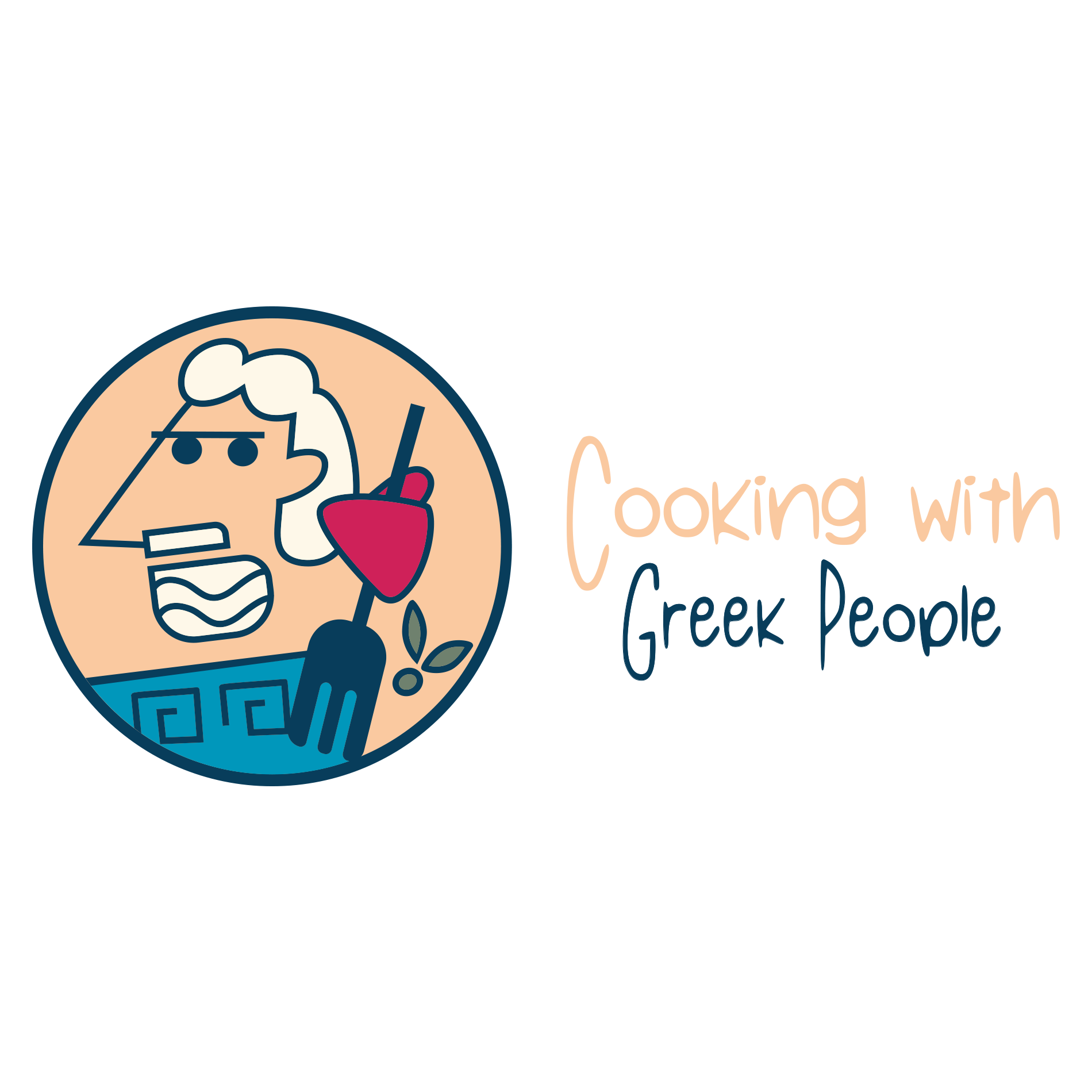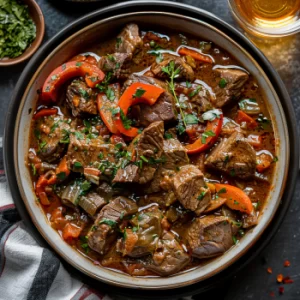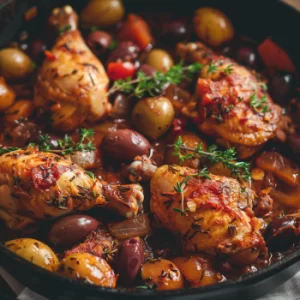Imagine a flaky, golden-brown phyllo crust that conceals a savory filling of fragrant pasturma (cured and seasoned meat) and melted cheese. Welcome to the world of Pastourmadopita, a traditional Greek delicacy that’s about to become your new favorite dish. This authentic Mediterranean treat is a crowd-pleasing masterpiece, combining the best of Greek flavors and textures in every bite.


Have you ever wondered what makes this Greek cheese pie so irresistible? Prepare to embark on a culinary journey that will tantalize your taste buds and leave you craving more. What secrets lie within the flaky layers of this traditional Greek pastry?
Key Takeaways
- Pastourmadopita is a savory Greek phyllo pie filled with pasturma (cured and seasoned meat) and cheese
- This traditional Mediterranean dish combines flaky phyllo crust with a flavor-packed filling
- Pastourmadopita is a crowd-pleasing treat that showcases the best of Greek cuisine
- Exploring the unique flavors and textures of this Greek cheese pie will leave you captivated
- Learn how to make this authentic Greek baked filo pastry at home
Savory Greek Pasturma & Cheese Pie: A Crowd-Pleaser
The Greek Phyllo Pie, also known as Pastourmadopita, is a beloved Mediterranean Savory Pie that combines the rich flavors of pasturma (a type of cured and seasoned meat) and tangy Greek cheeses. This Traditional Greek Pastry is not only a delight for the senses but also a true Crowd Pleaser, making it the perfect choice for dinner parties, gatherings, or as a satisfying appetizer.
Quick Assembly and Flavorful Ingredients
What sets the Pastourmadopita apart is its remarkably simple assembly process. In just 10 minutes, you can have this Authentic Greek Pie ready for the oven. The key to its success lies in the carefully selected ingredients:
- Pasturma, the star of the show, lends its bold and savory flavors to the dish.
- Greek cheeses, such as kasseri or kefalograviera, provide a creamy and tangy counterpoint.
- Fresh vegetables, like tomatoes and bell peppers, add a delightful crunch and vibrant color.
The harmonious blend of these flavors creates a Pastourmadopita that is sure to delight your guests and leave them craving more of this Traditional Greek Pastry.
| Ingredient | Quantity | Purpose |
|---|---|---|
| Pasturma | 1 lb | Provides the bold, savory flavor |
| Greek Cheese (Kasseri or Kefalograviera) | 2 cups, grated | Adds a creamy and tangy element |
| Tomatoes | 2 cups, diced | Adds freshness and crunch |
| Bell Peppers | 1 cup, diced | Enhances the overall flavor and texture |
“The combination of rich, bold flavors and the quick assembly process make this Pastourmadopita a true Crowd Pleaser for any occasion.”
What is Pasturma?
Pasturma, a type of cured and seasoned meat, is a staple ingredient in Greek, Turkish, Armenian, and Mediterranean cuisine. This unique meat is typically made from beef that has been meticulously seasoned with a blend of aromatic spices, including fenugreek seeds, garlic, and pepper, before being air-dried. The resulting Cured Meat has a bold, distinctive flavor that pairs exceptionally well with a variety of savory ingredients, making it a beloved component in many traditional dishes.
Exploring the Unique Flavors of Pasturma
The process of creating Pasturma is a laborious one, but the effort is well worth it. The curing and drying techniques used to produce this delicacy imbue the meat with a complex and deeply satisfying taste. As the beef is cured, it develops a firm, almost chewy texture and a robust, concentrated flavor that is further enhanced by the fragrant spice blend.
One of the key elements that contribute to the unique taste of Pasturma is the use of fenugreek seeds. These small, golden-brown seeds impart a slightly sweet, nutty, and slightly bitter flavor profile that complements the savory nature of the meat. The addition of garlic and pepper further elevates the overall taste, creating a harmonious blend of aromatic and spicy notes.
When incorporated into dishes, Pasturma adds a depth of flavor that is unparalleled. Its bold, assertive taste can hold its own against strong cheese, eggs, and other hearty ingredients, making it a versatile and indispensable component in Greek, Turkish, and Armenian cuisine.
Ingredients for the Pastourmadopita, Phyllo Pie, Greek Cheese Pie
To create the delectable Pastourmadopita, a mouthwatering Greek phyllo pie with pasturma and cheese, you’ll need a few key ingredients. This Mediterranean pie combines the savory flavors of pasturma, a cured and spiced meat, with an array of flavorful cheeses and fresh vegetables.
The primary components for the Pastourmadopita Ingredients include:
- Phyllo dough sheets, for the flaky, layered crust
- Slices of pasturma, the star ingredient that adds a unique, robust flavor
- A blend of cheeses such as gouda, kasseri, kefalograviera, gruyere, or mozzarella
- Cherry or grape tomatoes, for a burst of freshness
- Bell peppers, sliced for a crunchy texture and sweet notes
- Dried oregano and black pepper, to season the Greek Cheese Pie Ingredients and Mediterranean Pie Ingredients
The assembly process for this Greek Phyllo Pie Ingredients is straightforward, with layers of phyllo, cheese, pasturma, and vegetables coming together to create an authentic and flavorful Greek pie. The end result is a savory and satisfying Pastourmadopita that is sure to delight your taste buds and impress your guests.
| Ingredient | Quantity |
|---|---|
| Phyllo dough sheets | 1 package (8-10 sheets) |
| Pasturma slices | 8-10 slices |
| Gouda cheese, grated | 1 cup |
| Cherry tomatoes, halved | 1 pint |
| Bell pepper, sliced | 1 medium |
| Dried oregano | 1 teaspoon |
| Black pepper | 1/2 teaspoon |
Where to Buy Pasturma for Your Greek Phyllo Pie
When it comes to recreating the authentic flavors of a traditional Greek Pastourmadopita, or Greek phyllo pie with pasturma and cheese, the key ingredient is none other than pasturma itself. Pasturma, a cured and air-dried meat with unique seasonings, is a crucial component that lends this savory pie its distinctive Mediterranean flair.
Substitute Options for Pasturma
If you’re unable to source pasturma in your local grocery stores, don’t fret. There are a few suitable substitutes that can help you achieve a similar taste profile in your Pastourmadopita. One popular alternative is pastrami, which shares many of the same bold flavors and textures as pasturma. Pastrami can be found at most well-stocked supermarkets or specialty delis, making it a convenient replacement.
Another option to consider is using a combination of cured, smoked, or spiced meats, such as Mediterranean cuisine ingredients like prosciutto, chorizo, or even salami. While they may not replicate the exact taste of pasturma, these meats can still provide a savory and satisfying filling for your Greek phyllo pie.
When it comes to the cheese component, traditional options like kasseri or kefalograviera are ideal. However, you can also experiment with a blend of other melty, flavorful cheeses such as gouda or gruyère, depending on your personal preferences and what is readily available in your area.
| Pasturma Substitutes | Cheese Alternatives |
|---|---|
| Pastrami | Kasseri |
| Prosciutto | Kefalograviera |
| Chorizo | Gouda |
| Salami | Gruyère |
With a little creativity and flexibility, you can easily source the necessary ingredients to craft a delicious and authentic-tasting Pastourmadopita right in your own kitchen, even if pasturma is not readily available in your area.
Baking Instructions for the Perfect Pastourmadopita
Preparing the perfect Pastourmadopita, or Greek phyllo pie with pasturma and cheese, is a straightforward process that yields mouthwatering results. Whether you’re a seasoned baker or a novice in the kitchen, following these baking instructions will guide you towards creating a delightful Mediterranean-inspired dish.
To begin, preheat your oven to 400°F (200°C). This high temperature is essential for achieving the signature golden-brown, crispy crust that characterizes the Pastourmadopita.
Next, assemble the pie by layering the phyllo dough, savory pasturma, and flavorful Greek cheese in a 10-inch round baking pan. Be sure to alternate the phyllo layers, brushing each one with a light coating of melted butter or olive oil to ensure a flaky, golden-hued exterior.
- Preheat your oven to 400°F (200°C).
- Assemble the Pastourmadopita by layering the phyllo dough, pasturma, and Greek cheese in a 10-inch round baking pan.
- Bake the pie for 35-40 minutes, or until it is golden brown and crispy.
- Once the Pastourmadopita is out of the oven, let it rest at room temperature for 10 minutes before slicing and serving.
Bake the Pastourmadopita for 35-40 minutes, or until it is golden brown and crispy. The high oven temperature and carefully constructed layers will ensure that the pie bakes to perfection, with a flaky, buttery crust and a savory, melted cheese filling.
When the Pastourmadopita is freshly out of the oven, let it rest at room temperature for 10 minutes before slicing and serving. This resting period allows the cheese to set, creating a neat and tidy presentation for your guests to enjoy.
| Baking Time | Oven Temperature | Resting Time |
|---|---|---|
| 35-40 minutes | 400°F (200°C) | 10 minutes |
By following these Pastourmadopita baking instructions, you’ll be well on your way to creating a delectable Greek phyllo pie that is sure to impress your family and friends. Enjoy the combination of flaky pastry, savory pasturma, and melted cheese in every bite of this Mediterranean masterpiece.
Scoring the Pie: A Crucial Step for Serving
When it comes to Scoring Pastourmadopita, the Greek phyllo pie with pasturma and cheese, a crucial step emerges for ensuring a seamless serving experience. As the delicate phyllo dough can be prone to crumbling, scoring the Cutting Greek Phyllo Pie before baking is an essential technique that will help the Serving Mediterranean Pie hold its shape and allow you to neatly slice and serve it.
The scoring process is straightforward but impactful. Prior to baking, use a sharp knife to gently score the top layer of the phyllo dough, dividing it into 8 equal pieces. This pre-cutting ensures the pie will easily separate into neat, well-defined slices once baked.
- Carefully score the phyllo dough top layer into 8 equal pieces before baking.
- This pre-cutting technique helps the Pastourmadopita hold its shape and enables clean, effortless slicing.
- Scoring the pie is a simple yet crucial step for serving this delectable Greek cheese pie with pasturma.
“Scoring the phyllo dough is the secret to serving Pastourmadopita with elegance and ease.”
By taking the time to score the Cutting Greek Phyllo Pie before baking, you’ll ensure the Serving Mediterranean Pie emerges from the oven ready for seamless slicing and serving. This small but impactful step elevates the presentation and enjoyment of this savory Greek specialty.
Make-Ahead Options for Effortless Entertaining
Hosting a gathering can be a delightful experience, but the preparation can sometimes feel overwhelming. Fortunately, the beloved Pastourmadopita, a savory Greek phyllo pie featuring pasturma and cheese, offers a fantastic make-ahead solution that simplifies your entertaining journey.
Freezer-Friendly Pastourmadopita Rolls
For even more convenience, you can transform the traditional Pastourmadopita into mouth-watering Frozen Pastourmadopita Rolls. These handy pastries can be prepared in advance and frozen for up to 2 months, allowing you to have Entertaining with Greek Pie at your fingertips whenever the occasion arises.
To make the Frozen Pastourmadopita Rolls, simply assemble the pie filling, roll it up in phyllo dough, and pop them in the freezer. When you’re ready to serve, simply bake the rolls directly from the freezer, and voila! You have a delicious and impressive appetizer or side dish that’s sure to delight your guests.
The ability to prepare the Pastourmadopita in advance and have Frozen Pastourmadopita Rolls on hand allows you to focus on other aspects of your event, ensuring a stress-free and enjoyable Entertaining with Greek Pie experience for both you and your guests.
“The key to effortless entertaining is having make-ahead options that allow you to spend more time with your guests and less time in the kitchen.”
Whether you opt for the traditional Pastourmadopita pie or the convenient Frozen Pastourmadopita Rolls, you’ll be able to savor the flavors of this beloved Greek dish while enjoying the company of your loved ones.
Variations and Serving Suggestions for Your Greek Cheese Pie
While the traditional Pastourmadopita features the savory flavors of pasturma and a blend of Greek cheeses, you can easily experiment with variations to suit your taste buds. Swap out the pasturma for other cured meats or try incorporating a different cheese selection, such as a combination of feta, kefalotiri, and gruyere.
When it comes to serving the Pastourmadopita, the options are plentiful. Enjoy it as a hearty main dish, accompanied by a fresh Mediterranean salad for a complete meal. Alternatively, cut the pie into smaller pieces and serve it as an appetizer, perfect for sharing with friends and family. To round out your Mediterranean feast, consider pairing the Pastourmadopita with traditional Greek side dishes like tzatziki sauce, dolmades, or roasted vegetables.
Regardless of how you choose to serve this delightful Greek cheese pie, your guests are sure to be delighted by the layers of flaky phyllo, savory fillings, and the rich, creamy flavors that make the Pastourmadopita a true crowd-pleaser.
FAQ
What is Pastourmadopita?
What are the key ingredients in Pastourmadopita?
What is pasturma and how does it contribute to the flavor of Pastourmadopita?
Can I substitute pasturma if I can’t find it?
What type of cheese is best for Pastourmadopita?
How do I bake the perfect Pastourmadopita?
Why is scoring the Pastourmadopita important?
Can I make Pastourmadopita ahead of time?
How can I serve Pastourmadopita?
Welcome to “Cooking with Greek People,” your go-to YouTube channel for discovering the rich, flavorful, and diverse world of Greek cuisine! Whether you’re a seasoned chef, a home cook, or someone who just loves great food, our channel is designed to bring the heart of Greece into your kitchen.


Healthy Greek Cooking for Modern Lifestyles
Greek cuisine is evolving with modern twists on traditional dishes, blending Mediterranean flavors with global influences. From quinoa moussaka to lentil dolmades, these recipes cater to health-conscious diners while preserving authentic tastes. Greek fusion recipes combine the bold flavors of Greece with the aromatic profiles of Asian ingredients, offering unique culinary experiences like miso-glazed lamb souvlaki and tzatziki-stuffed chicken skewers.
Vegan Greek recipes are transforming traditional dishes into plant-based versions, highlighting the versatility of Greek ingredients. For more details and recipes, visit the following links: Modern Greek Recipes, Modern Greek Salads, Easy Greek Dinners, Greek Breakfast Recipes, Greek-Inspired Cocktails, Greek BBQ Recipes, Greek Snack Recipes, Greek-Inspired Soups, Greek Pasta Dishes, and Greek-Inspired Pizza.
Author: Bob
With over 20 years in Bioinformatics and AI in Molecular Diagnostics, Bob Stavrou advises BiCos, focusing on authenticating OLIVE OIL DNA. He's also a passionate contributor to YouTube Cooking with Greek People and appeared on Greek TV show Savvatokiriako Me Ton Manesi, bridging science and culinary arts. Watch it on Alpha TV.





